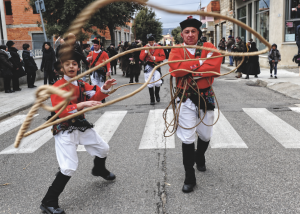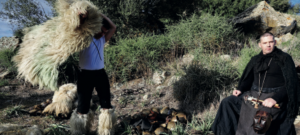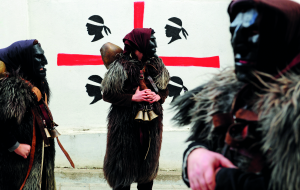Photojournalist Marina Spironetti travelled to inland Sardinia and the remote region of Barbagia to document the most fascinating and ancient carnival traditions of the island…

The glitzy atmosphere of the Costa Smeralda could not be further away. That coastline may be what the island is most famous for, but it’s not the real Sardinia – as any local would promptly tell you. I am in inland Sardinia, in the mountainous region of Barbagia, far from the crystal-clear water and also far from those summer images that the island seems to evoke in the minds of many people.
It’s the beginning of February and all the little villages and towns are getting ready to celebrate the last week of Carnival – su Carresegare, as it’s called in Sardinian. This is when those heavy sheepskin costumes are taken out of the wardrobe; when those wooden masks of silence and impassibility are worn again; when faces are painted black with soot, in preparation for centuries-old rituals.
Visitors are in for a unique experience and can count on the famous hospitality of the locals, who are happy to share their wine and food with whoever may come to celebrate with them.
This Carnival story is about four distinct traditions: Boes e Merdules in the town of Ottana; the Mamuthones in Mamoiada; sos Thurpos in Orotelli; and su Battileddu in Lula. All of these traditions have in common the same heritage, which dates as far back as the Nuragic civilisation (the 18th century BC to the 2nd century AD). Yet there is no certainty as to the true meanings of these ceremonies, which could be related to anything from fertility rites to ancient Dionysian cults.
Whatever the origins, however, these traditions have survived fundamentally intact over the centuries – they haven’t bowed to pressure from Christianity to alter them, unlike most Italian traditions that were originally born as pagan and later adopted to more Catholic-friendly values. In short, they have managed to stay uniquely Sardinian. And that is their true beauty.
So let the journey begin!
Boes e Merdules, Ottana

Everybody in Ottana is welcome to take part in the Carnival. Aside from the associations who are behind the organisation of the parades, people get dressed and get out on the streets on their own initiative. Even the youngest look the part, like this little girl, who is a perfect miniature filonzana (weaver woman).
The main parades in Ottana take place on Shrove Sunday and Shrove Tuesday but on Shrove Monday there is a special event dedicated to children.
The costumed figures of Boes and Merdules pose for pictures in front of the Nuraghe Attentu, on the outskirts of the town of Ottana. The Boes (literally, the oxen) wear long-horned wooden masks resembling the head of an ox, and a heavy array of bells across their chest. The Merdules (literally, the masters of the bulls), in their almost sinister masks, carry whips and sticks with them to control their Boes.
Most probably, the Carnival of Ottana refers to a ritual dating back to the cult of Dionysus. Also, the figure of the ox gives a distinct agro-pastoral characteristic to the event. The worship of the bull – seen here, as it is throughout Europe, as a symbol of strength and energy – has been practised since Neolithic times.
A man gets into his cumbersome costume, which includes a sheepskin cloak and traditional shepherd shoes. Next to him, the costumed figure of Sa Filonzana, the weaver woman dressed in black from head to toe. This character reminds us of the Greek goddess Clotho, the youngest of the three Moirai. She was responsible for spinning the thread of human life, deciding over the life and death of humans. Just like in the Ancient Greek theatre, women’s roles are played by man. Aside from Sa Filonzana, all the other characters of the Carnival of Ottana wear a female headscarf, as a tribute to women.
Mamuthones, Mamoiada

The sombre costumes of the Mamuthones stand out against a mural depicting the Sardinian flag in the town of Mamoiada. They are among the best-known traditional-costumed figures of the entire island, decked out as they are in their sheepskins, on which a heavy tangle of cowbells is strung.
Despite their rather eerie appearance, they are actually perceived as symbols of abundance, good luck and happiness. Their bells, skillfully crafted in the nearby town of Tonara, ring out simultaneously each time
the Mamuthones perform synchronised leaps, creating a very dramatic, almost primitive rhythm.
Apart from the parade, the most evocative moment of the whole tradition actually happens behind closed doors, when the participants get together to help each other into their bulky costumes and the rather elaborate bundle of cowbells. It is a very intimate moment for each one – even close family members are not allowed to witness it.
“It feels very special,” explains one. “Wearing our costume is like going back to our roots. It means finding our origins.”
The red-jacketed Issohadores are the other costumed figures that accompany the Mamuthones on their parade. In contrast with the slow movements of their counterparts, the Issohadores move around with agile steps and jumps, twirling their lassos towards the crowds. Getting tangled in their rope is considered a good omen.
Although the true meaning of this carnival has been lost for ever behind the Mamuthones’ dark masks, it might represent a celebration of the victory of the shepherds (represented by the Issohadores) against the Saracen invaders (the Mamuthones), who are imprisoned and led in procession. According to other theories, it could be related to ancient Dionysian celebrations or fertility rites.
